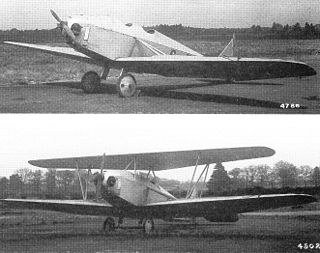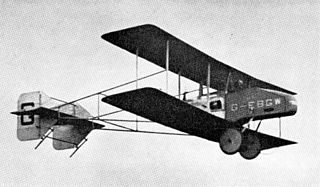Related Research Articles
Parnall was a British aircraft manufacturer that evolved from a wood-working company before the First World War to a significant designer of military and civil aircraft into the 1940s. It was based in the west of England and was originally known as George Parnall & Co. Ltd.

The Short Springbok was a two-seat, all-metal reconnaissance biplane produced for the British Air Ministry in the 1920s. All together six aircraft of the Springbok design were built but none entered service with the armed forces.

The de Havilland DH.53 Humming Bird is a British single-seat, single-engine, low-wing monoplane light aircraft first flown in the 1920s.

The ANEC I and ANEC II were 1920s British single-engine ultralight aircraft designed and built by Air Navigation and Engineering Company Limited at Addlestone Surrey. One was privately constructed in Brisbane, Australia.
The Avro 558 was a British single-engined ultralight biplane built by Avro at Hamble Aerodrome.

The Avro 560 was a British single-engined ultralight monoplane built by Avro at Hamble Aerodrome.
The Bristol Type 91 Brownie was a light sports aircraft produced in the United Kingdom by the Bristol Aeroplane Company in 1924. It was a low-wing cantilever monoplane aircraft of conventional configuration with fixed tailskid undercarriage. The pilot and passenger sat in tandem open cockpits. It won the £1,000 pound prize for second place at the Lympne light aircraft trials in October 1924.

The Supermarine Sparrow was a British two-seat light biplane designed by R.J. Mitchell and built at Supermarine's works at Woolston, Southampton. It first flew on 11 September 1924. After being rebuilt in 1926 as a parasol monoplane, it was re-designated Sparrow II.
Nicholas Comper was an English aviator and aircraft designer, whose most notable success was the 1930s Comper Swift monoplane racer.

The Vickers Viget was Vickers' entrant for the first Lympne light aircraft competition, held in 1923. It was a single-seat, single-engined biplane with folding wings.
The Handley Page H.P.22 and H.P.23 were single-seat sport monoplanes produced for the 1923 Lympne light aircraft trials. They were not successful.

The Parnall Pixie was a low powered British single-seat monoplane light aircraft originally designed to compete in the Lympne, UK trials for motor-gliders in 1923, where it was flown successfully by Norman Macmillan. It had two sets of wings, one for cross-country flights and the other for speed; it later appeared as a biplane which could be converted into a monoplane.
The Beardmore Wee Bee was a single-engined monoplane built only once and specifically for the Lympne two-seat light aircraft trials held in the United Kingdom in 1924. This plane won the major prize.
The RAE Hurricane was a single-seat, single-engined light monoplane designed and built by the Aero Club of the Royal Aircraft Establishment for the 1923 Lympne Motor Glider Competition. It was underpowered with an unreliable engine. Re-engined, it flew in many races, with first place in the 1926 Grosvenor Challenge Cup its greatest success.
The Lympne Light Aircraft Trials were held to encourage the development of practical light aircraft for private ownership, with a strong but not exclusive emphasis on fuel economy. They were held in 1923, 1924 and 1926. Each year saw different restrictions on engine size, framed initially in terms of capacity and then weight. The Daily Mail newspaper provided cash prizes throughout though the initiating donation came from the Duke of Sutherland. The Air Ministry were prize givers in the 1924 event. The trials were held at Lympne in Kent, England.

The RAE Zephyr was a single-seat, single-engined light pusher configuration biplane designed and built by the Aero Club of the Royal Aircraft Establishment (RAE) for the 1923 Lympne Motor Glider Competition. At a late stage the Aero Club chose to enter the more promising RAE Hurricane instead, using the Zephyr's engine, and the Zephyr itself was abandoned.

The Handasyde monoplane was a single-seat light aircraft built for the 1923 Lympne motor glider competition. It competed there but won no prizes.
The Peyret Tandem or Peyret Alérion, was a French single seat glider of tandem wing configuration. It won first prize at the first British Glider Competition of 1922.
The Grosvenor Challenge Cup, commonly known as the Grosvenor Cup, was a trophy presented by Lord Edward Grosvenor in 1923 to the winner of a light aircraft time trial competition. Entries were initially restricted to British designs using aero engines of less than 150 horsepower. The first competitions were held at Lympne Aerodrome in Kent. The contest continued until 1935 with a break to 1949 when the Royal Aero Club resumed the races at Elmdon where the entry was opened to British and international designs with a weight less than 1,000 kilograms.
The Cranwell Light Aeroplane Club was formed in 1923 by staff and students of the RAF College Cranwell to design and build light aircraft. One of the members was Flight Lieutenant Nicholas Comper who became the Chief Designer. Comper and the club designed and built four aircraft with the last three types being flown.
References
Notes
- ↑ "Lympne Avietta Competition – Entries for Duke of Sutherland's Prize". The Times. No. 43461. London. 2 October 1923. col D, p. 9.
- 1 2 3 4 Ellis 1979, p. 131
- ↑ Jackson, A J (Aubrey Joseph) (1973). British civil aircraft since 1919 (Volume Three). London, UK: Putnam & Company Limited. p. 289. ISBN 037010014X.
Bibliography
- Ellis, Ken British Homebuilt Aircraft since 1929. Liverpool, England:Merseyside Aviation Society, 1979. ISBN 0-902420-321